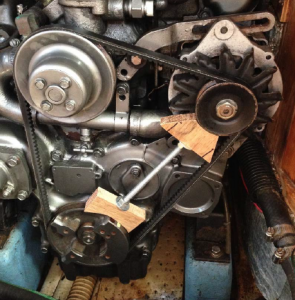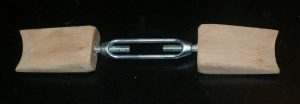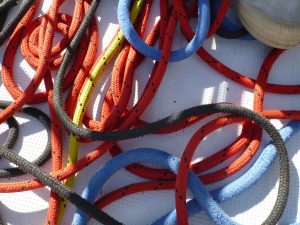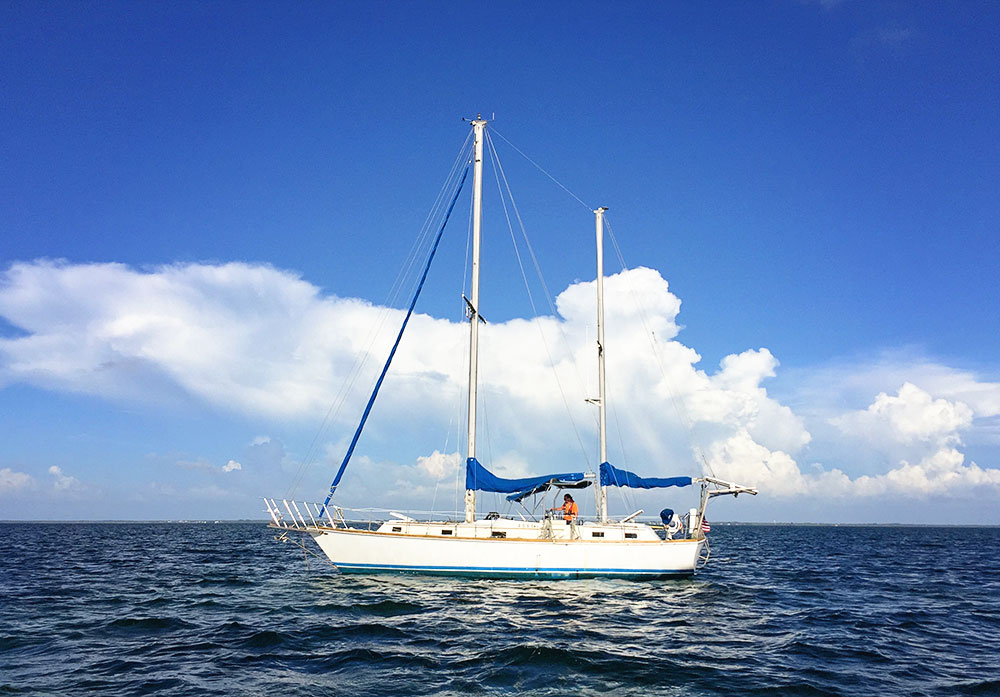Great alternator tensioning device

Dave Lochner’s solution
In the June Good Old Boat Newsletter Dave Lochner has an article (“DIY V-Belt Tensioning”) with an excellent idea about tensioning the alternator belt. On my Pearson 365, the access is one-handed or two people from different directions. David’s idea was good but seemed to need two hands. I created a one-handed way to tension the belt using a 5/16-inch galvanized turnbuckle from Home Depot and a couple of scrap pieces of wood. The wooden end pieces are about 1 ¾ inches by 3 inches by ¾ inch and tapered to fit into the pulley grooves. I sawed off the eye ends of the turnbuckle and glued them into the wooden blocks as shown. I place the tensioner between the pulleys and with one hand I can turn the body to lengthen it until it begins to tension the belt. A small screwdriver is necessary to get the proper tension. Thanks, Dave!
–Jim Shell, The Woodlands, Texas
Dave Lochner responds

Jim’s alternative
Jim, thanks for taking the time share your thoughts. Yes, a turnbuckle would work and is a more attractive alternative. In practice, only one wrench is needed to adjust my tensioner. Once the tension increases, the pressure holds the other nut in place. And it takes only a few turns to reach the proper tension. The idea is to get the belt tension close to specs by hand and to then use the tensioner to add that little extra and hold everything in place while the alternator bolts are tightened. If you are lucky, the nuts are the same size as the bolts on the alternator and only one wrench needs to come out the tool box. I have a Yanmar, so I’m not that lucky as the bolts are metric. Hmmm, maybe I need to find some metric threaded rod.
I’m glad you found the article useful.
–Dave Lochner, Good Old Boat contributor
Leaping Like Gazelles – or like Karen
I can understand Jerry’s concern and Karen’s reaction to bringing all lines into the cockpit (“Put it to the Readers,” June 2017 Newsletter). I made that decision when I re-rigged my Down East 45, Britannia, from a ketch to a brigantine schooner. When I did that I changed all my sails to roller furling, including the squaresail on the foremast. It is certainly easier to unfurl and furl any sail, as opposed to hauling it up a stay or mast. It is also easier to shorten these sails, even if they don’t set so well. There are pros and cons to both systems of course, but I decided it was the least disadvantage to bring all my running lines back to the cockpit.
The problem I had was the sheer number of lines from five working sails—a total of twelve! And this number does not include halyards, because they are permanent on furling sails. As you noted, this number of lines in the cockpit presents both a handling and storage problem. Luckily the cockpit on my boat has a large flat area on both sides of the companionway.
To solve the line handling issue, I installed a bank of six rope clutches on each side, with all lines tailable to a common self-tailing winch on each side.
To solve the line storage problem, I turned teak belaying pins and mounted them on each side of our “rope deck,” as we now call it. This is better than trying to stow lines in a bin or bag(s) or all in a pile. (See http://schooner-britannia.com/running_rigging.html).
I would be lying if I wrote that this lot doesn’t sometimes get into a bit of a tangle, but we have learned to handle them, just as we would if they were on deck. For us there are a few major advantages we think worthwhile, apart from the obvious safety consideration of not having to leave the cockpit.
First, because the cockpit winches are self-tailers, we can use our fabulous Winchrite electric winch winder. We couldn’t use the Winchrite on the non-self-tailing mast-mounted winches because we can’t hold the Winchrite sideways and tail the line at the same time. For our worn-out hands that’s a God-send.
Second, the lines don’t necessarily have to be cleated off and coiled like they would were they at the mast. When we are in a hurry we simply lock them with the jammers and sort them out later.
Third, either my wife or I are able to work the sails and steer at the same time. Or we can switch on the pilot for a minute while we both do it.
Fourth, it’s always dry under the bimini.
All in all it’s the best modus operandi for us, but then, we’re both over seventy and no longer much good at leaping over the foredeck like gazelles—or like Karen.
–Roger Hughes, Orlando, Florida
Agree with Karen
I agree with Karen. (“Put it to the Readers,” June 2017 Newsletter)
My boats are set up so the only lines that lead to the cockpit area are the sheets and vang/preventers (when rigged). As Karen notes, she has to go forward to attach the main and jib halyards to the sails before raising them, then return to the cockpit to do so. If there is a snag, she might have to go forward again to clear it. So why not just work at the mast while there, taking fewer trips along the rail.
In addition, having the lines secured at the mast and coiled there eliminates a mess aft that can lead to slips and falls in a supposedly secure area, tangled lines when one doesn’t want them (perhaps in an emergency), and a cluttered work space which might lead one to grab the wrong line and do the wrong thing.
My belief is the rig should be as simple, clean, and uncluttered as possible as it makes for a more enjoyable sail.
–Mark Fontaine, HR 28 Marquesa II
Romance borne of infatuation

A tangle of lines
I read your “rant” about leading lines aft to the cockpit (“Put it to the Readers,” June 2017 Newsletter) with a few chuckles and a loud “Yes, I remember when…” Over our 30+ years of owning and restoring good old boats, we have romanced the idea of the safety and efficiency of having all lines led to the cockpit. However, like all romance instigated by infatuation rather than true love, we have realized that all lines led aft is not a great solution.
On boat #2, a 32 foot Pearson Vanguard, we led all lines aft so that we could be safely in the cockpit while managing the mainsail. We led the halyard, vang control line, and all reefing lines to the cockpit. We installed a winch on the cabin top under the dodger. Yes, we were able to control the mainsail from the cockpit rather than from atop the heaving and heeled cabin top. However, the jumble of lines in the cockpit was an issue that never could be ignored. We had 6 lines all residing in the forward end of our cockpit: halyard, vang line, 2 reefing lines for the tack, and 2 reefing lines for the clew.
We all know the truth about the legendary tendency of lines to self-tangle and perform the most complicated knots ever imagined all by their lonesome. Yep, those 6 lines became more than intimate in our cockpit. So that we could actually helm the boat, one of us had to coil those lines so they would be out of the way. Because we needed to be ready for any change of wind and sea conditions, we could not secure the neatly coiled lines.
On boat #2, having the lines led aft did make controlling the mainsail potentially safer, but also added challenges to cockpit organization. That mess of lines in the cockpit may have made our cockpit less safe. Those six mainsail lines always tried to hanky-panky with the headsail sheets. Yes, not unlike chaperoning a teenage dance!
On boat #3, our Westsail 42 Ketch, the only line led aft to the cockpit was the main halyard. We don’t have a boom vang yet, but all of the reefing lines, three in fact, reside on the boom. The main halyard was led to an electric winch for raising the main. The electric winch was a nice feature, but actually a luxury we rarely used. With a 50 foot mast, the amount of 1/2 inch line snaking around the cockpit was a mess. Moreover, reefing the main was a complicated dance between the cockpit and the mast.
We generally sail with just the two of us, and the constant moving back and forth between the cockpit and the mast only raised the risk of a stumble in rough seas. Moreover, with all the other reefing control lines at the mast, I questioned the sanity of having the main halyard led aft, even if the luxury of an electric winch would be forfeited. And there was another issue, of course! The amount of friction in the fairleads for the running the halyard aft massively interfered with a quick and smooth drop of the main. I had to literally drag the main down to drop it.
Solution? We put the main halyard back at the mast. What I didn’t say before was that our Westsail 42 has a mast pulpit within which one can safely work in most sea states. I can now reef simply at the mast and take less time to secure the tack and clew at each of the 3 reef points. When we drop the main, it now falls quickly to the boom. Note: we have a Dutchman system rather than lazyjacks and we are happy with how it works. Our cockpit is now only cluttered with headsail sheets for both the yankee/genoa and staysail, as well as the main sheet. Those are easily coiled on the cockpits seats and out of the way.
Okay, with my somewhat lengthy experience with leading lines aft, what is my final conclusion or assessment? Well, I would not advise anyone to lead lines aft. While controlling lines from the relative security of the cockpit is an alluring feature, the added complexity, friction, and general mess in the cockpit outweighs whatever benefits are perceived. I have realized that the ease and speed of controlling mainsails from the mast actually reduces risk when conditions require reefing. Moreover, all sailors should be able to secure themselves to the boat while working the foredeck, the mast, or the deck. While most boats do not have the luxury of mast pulpits, the ability to raise, lower, and reef the sail plan from the main mast quickly, and securely limits risk and maximizes safe sailing.
Yes, there are those newer boats that seem to operate and sail by just pushing buttons. While seemingly easy and potentially wonderful, these automated features actually insulate or remove one from the experience of sailing. Call me old-fashioned or a kook, but being able to participate in all the regimens of sailing a boat makes the experience joyous and full for me. One should seriously consider the plusses and minuses before leading lines aft to the cockpit, no matter what size boat one sails.
Thanks for the great magazine!
–Doug Tate, Harmony, WS42 Ketch, Marion, MA





